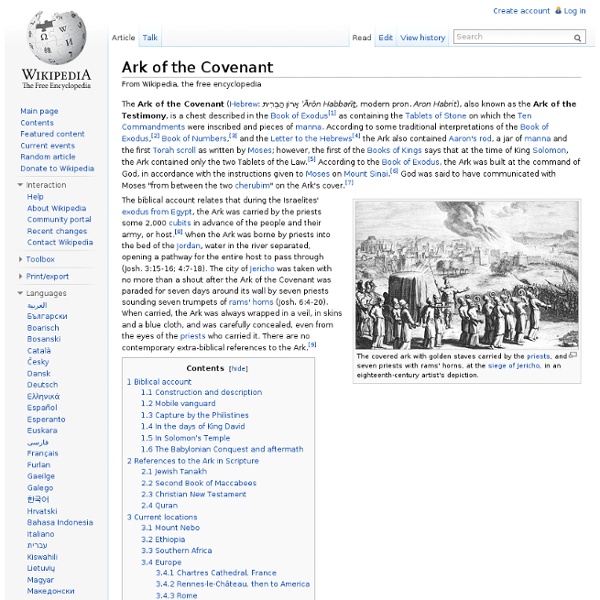Ephod
Jewish High Priest wearing the sacred vestments. The ephod is depicted here in yellow. An ephod (Hebrew אֵפוֹד) (/ˈɛfɒd/ or /ˈiːfɒd/) was an article of clothing, and an object of worship in ancient Israelite culture, and was closely connected with oracular practices and priestly ritual. In the Book of Judges, Gideon and Micah each cast one from a metal, and Gideon's was worshipped (Judges 8:26-27, Judges 17:5). Description[edit] Within the Bible, in the contexts where it is worn, the ephod is usually described as being linen, but did not constitute complete clothing of any kind, as the Books of Samuel describe David's wife Michal as taunting him for indecently exposing himself by wearing one.[1] Though some Bible translations insert the word "only" before ephod (inferring David was indecent), the book of 1 Chronicles states that David was "clothed with a robe of fine linen, as were all the Levites who bore the ark... Wearing and composition[edit] Origins[edit] Extended uses[edit]
Priestly breastplate
The breastplate of the High Priest. Hebrew Bible[edit] According to the description in Exodus, this breastplate was attached to the ephod by gold chains/cords tied to the gold rings on the ephod's shoulder straps, and by blue ribbon tied to the gold rings at the lower parts of the ephod (Exodus 28:15-19). The biblical description states that the breastplate was also to be made from the same material as the Ephod - embroidered linen - and was to be a square, a cubit in width, two layers thick, and with four rows of three engraved gems each embedded upon it, each jewel being framed in gold.[3] The description states that the square breastplate was to be formed from two equal rectangular[clarification needed] pieces of cloth - suggesting that its appearance was similar to a backless waistcoat, with a pouch inside to contain the Urim and Thummim. The Jewels[edit] Artist's conception of Jewish high priest wearing a hoshen in ancient Judah. First row[edit] Second row[edit] Third row[edit]
Noah's Ark
Noah's Ark (1846), a painting by the American folk painter Edward Hicks A ship modeled after the biblical description of Noah's Ark, Ark van Noach, in the Netherlands Noah's Ark (Hebrew: תיבת נח; Biblical Hebrew: Tevat Noaḥ) is the vessel in the Genesis flood narrative (Genesis chapters 6–9) by which Noah saves himself, his family, and a remnant of all the world's animals from the flood. God gives Noah detailed instructions for building the ark: it is to be of gopher wood, smeared inside and out with pitch, with three decks and internal compartments; it will be 300 cubits long (137.16 m, 450 ft), 50 wide (22.86 m, 75 ft), and 30 high (13.716 m, 45 ft); it will have a roof "finished to a cubit upward"; and an entrance on the side. The Genesis flood narrative is similar to numerous other flood myths from a variety of cultures. There is no scientific evidence supporting a global flood. Origins[edit] Comparative mythology[edit] Traditions[edit] Rabbinic Judaism[edit] Christianity[edit]
Solomonic column
From Raphael's workshop, "Healing of the Lame Man," a cartoon for a tapestry that depicts Peter healing the lame man (Acts 3). The artist used the Solomonic columns in St. Peter's Basilica as models for the columns of the Jewish Temple Etymology and origin[edit] Unlike the classical example of Trajan's Column of ancient Rome, which has a turned shaft decorated with a single continuous helical band of low-reliefs depicting Trajan’s military might in battle, the twisted column is known to be an eastern motif taken into Byzantine architecture and decoration. Twist-fluted columns were a feature of some eastern architecture of Late Antiquity. Constantine's columns in their present day location on a pier in St. Solomonic columns entwined with grapevines in the frontispiece to Hugh Broughton, A Concent of Scripture, London, 1588 From Byzantine examples, the Solomonic column passed to Western Romanesque architecture. In Baroque architecture[edit] Bernini's baldacchino in St. Image gallery[edit]



